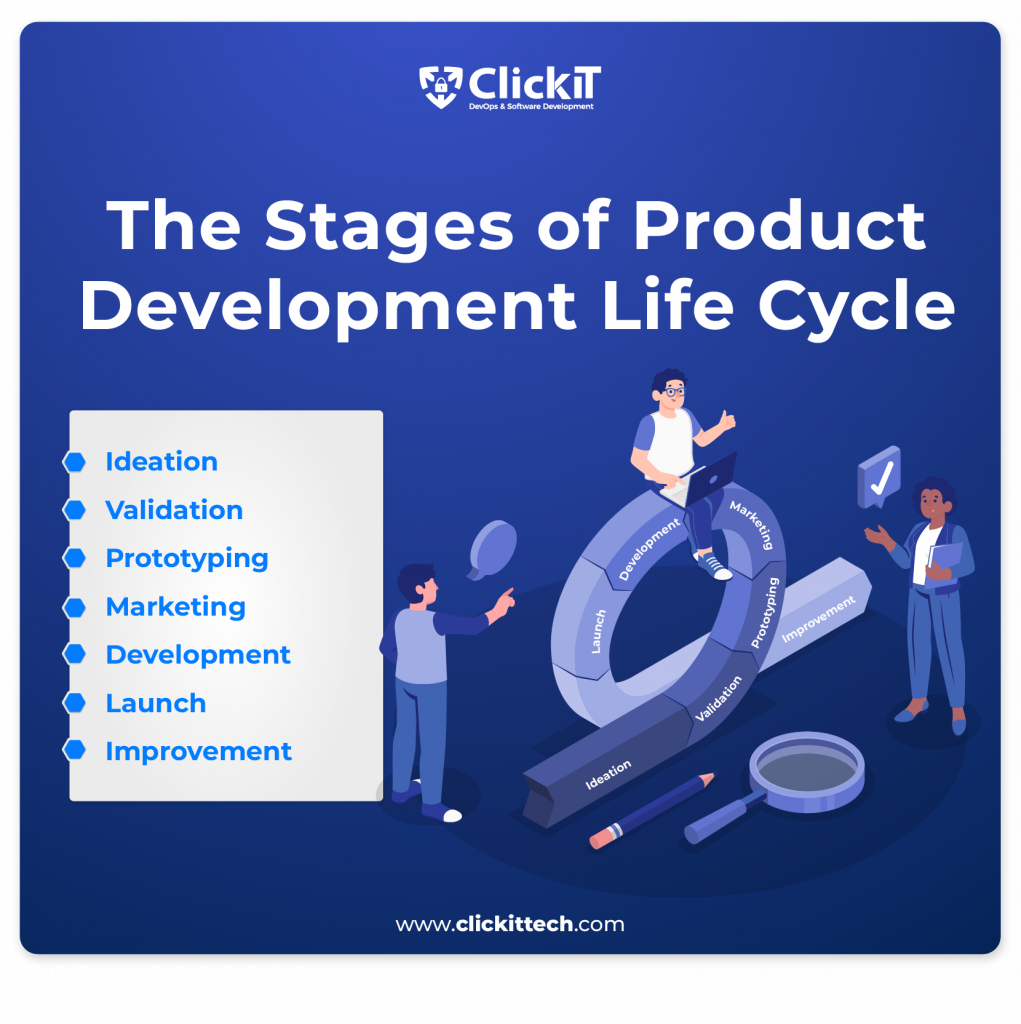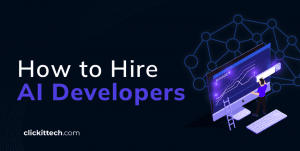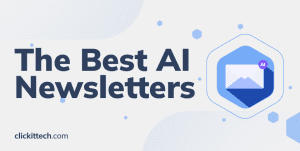Every journey we undertake in life has steps to reach our destination. It’s like the proverbial “Rome wasn’t built in a day.” This is also true in the product development life cycle. For a product to become useful to the customer, it must undergo sequential stages from the moment the idea was first conceived. All product development life cycle stages work hand-in-hand to ensure the product meets the user’s needs or expectations. So, we can’t skip any of them.
The product development life cycle stages are ideation, validation, prototyping, marketing, development, launch, and improvement. If you go through this creative process without trying to cut corners, you’ll reduce costs, build a quality product, and increase market competitiveness. You see, everybody wins!
Below, we’ll cover everything about the product development life cycle stages and what happens in each stage to help you build a winning product.
- Product Development Life Cycle vs Product Life Cycle
- The 7 Stages of Product Development Life Cycle
- Conclusion of Product Development Life Cycle
- Product Development Life Cycle FAQs
Product Development Life Cycle vs Product Life Cycle
It can be tricky to use product development lifecycle and product life cycle interchangeably. After all, it’s only one word, right? However, the keyword “development” differentiates these two terms.
The software product development lifecycle focuses on the stages of creating a product. That is, from when it was merely an idea till it was launched as a full-fledged product. However, the product life cycle begins immediately after the product enters the market until the day it becomes discontinued or loses its market share.
Think of product development as the step-by-step process of baking a cake. You follow a recipe and don’t skip any step to ensure the cake comes out perfect! But once it’s out of the oven, that’s the moment the product life cycle starts. Then, you serve the cake to the consumers and enjoy it, but eventually, it either gets eaten up or goes stale.
With that in mind, the product life cycle process typically looks like this:
- Introduction to the market.
- Growth – the product starts gaining popularity, and people use it more often.
- Maturity – the product has now reached its peak market penetration.
- Decline – the product loses its market share and is stopped.
But you may wonder, does this mean all products will reach the decline stage? No. However, most products will, so it’s important to start planning for a product’s eventual decline before it is even released into the market.
You can also read our blog about Software Development Life Cycle
The 7 Stages of Product Development Life Cycle
Successful products don’t come overnight. They result from a gradual, structured process that requires patience and ensures success throughout product development and beyond. Ultimately, your priority must be to focus on a lean, user-centric operation to deliver a minimum viable product (MVP), get customer feedback, and generate revenue as soon as possible.
That being said, here’s how you can break down the product development life cycle stages (some may have nine, but these are the fundamental seven).
- Ideation
- Validation
- Prototyping
- Marketing
- Development
- Launch
- Improvement

1. Ideation
Everything starts with an idea – even the biggest and most successful products today. This makes ideation the first step in your software product development lifecycle.
Ideation involves brainstorming a list of problems and identifying feasible ideas for a solution. During ideation, you may come up with ideas on your own, conduct market research and competitor analysis to find gaps, listen to the pain points of existing customers to see unmet needs or learn about new technologies that you could leverage to have a competitive edge.
To help your ideation, using the SCAMPER method can be effective. It’s a creative brainstorming technique that can help your team explore ideas from seven perspectives, ensuring you’re thinking outside the box.
SCAMPER stands for:
- Substitute – the elements of the product you can substitute.
- Combine – how you can combine this with other products or services to be complementary.
- Adapt – Is there an idea elsewhere you can alter or adapt?
- Maximize or Minimize – How can you significantly enlarge or reduce any component?
- Put to other use – What completely different use case can you have for your product?
- Eliminate – What components of the product can be eliminated?
- Rearrange or Reverse – How can you rearrange the product or reverse the process?
Now, you may be tempted to discard ideas when you judge them by face value – don’t. That’s why it’s important to use software that helps you write everything down and iterate later because creativity can be a flowing river, and one idea can lead to another.
Some tools that can help your brainstorming during ideation include Miro, Mural, or using storyboards. Even though it may seem old school, a pen and paper always works too!
2. Validation
The next phase of the product development life cycle stages is validation, where you determine which ideas will fly and those that should be discarded. The goal here is to sieve through the ideas to find the most promising concepts that could come to life.
To do this, you can conduct online surveys, interviews, A/B tests, and organize focus groups to evaluate the product’s market viability. Remember earlier when we discussed how “No Product-Market Fit” was the number one cause of product failures? This is where you avoid that problem.
Then, find the ideal buyer personas, which are your target audiences, and have discussions that help you narrow your focus down to a few ideas with the most chances of success. This is where you understand their needs and pain points to see how the product could solve them.
Don’t forget you need to make money to keep the lights on. So, assess how much they are willing to pay for this solution.
Lastly, here’s a great idea you’ll like. It’s always better to narrow customer groups. For example, let’s say you’re creating an app that helps people optimize the layout of their living spaces for functionality and aesthetic appeal.
Rather than targeting a large demographic, such as homeowners, you could narrow it down to a specific group, like urban millennials living in small apartments or studio flats. Focusing on these individuals can help you tailor your hypothesis validation and help gather quality insights from those most likely to enjoy your app’s offerings!
Feedback tools like Google Forms, SurveyMonkey, TypeForm, Qualtrics, and video conferencing software like Zoom can help you gather opinions and conduct interviews easily.
Additionally, user testing software like UserTesting, Validately, and Lyssna can also help, while landing page builders like Unbounce and Instagpage are great for creating and testing landing pages that validate product concepts.
3. Prototyping
Once you have a solid product idea and direction, the next stage of the product development life cycle is to build a prototype. Prototyping is an iterative process to create a physical model of your product.
This means you should first outline the key features and functionalities that are the foundation of your product and are based on the feedback from your validation. That is, the must-haves.
It’s important to be efficient here – the goal is to have a tangible representation of the look and feel of the product. So, you want to prototype in your product development life cycle stages and get feedback on the interface and features across each phase rather than waiting till the end.
Then, use wireframing tools like Sketch, Figma, or Adobe XD to create a mockup of the product that serves as a blueprint and outlines the layout and structure of the product’s screens or pages.
This typically includes user journeys and interactive elements like buttons and links. You may also consider prototyping tools like InVision, Proto.io, or Axure RP to create high-fidelity prototypes that simulate the real application better.
As a rule of thumb, focus on user experience and usability – the prototype must effectively communicate the unique value proposition (UVP).
4. Marketing
It’s time to start thinking about how to put the word out! Yes, you’ve not built the complete application yet, but it’s important to start building that buzz and generating anticipation for your product early on. And the best way to do that is by building a marketing and branding strategy that outlines your sales and promotion efforts.
Ideally, this should cover content, SEO, social media, press releases, email campaigns, word-of-mouth, and any other touchpoints relevant to your target audience. Reaching potential customers using a multi-platform or omnichannel approach can do you a world of good.
Tools like Buffer and Hootsuite can help schedule posts, monitor social media activity, and analyze performance metrics. SEMrush and Google Keyword Planner are great for content and SEO, Muck Rack works well for press releases, and MailChimp is a good tool to create an email list and optimize your email marketing campaigns.
Additionally, ensure all marketing materials zero in on your product’s value proposition. That is, the “why” it’s better than a competitor or the solution the buyers have been looking for.
Finally, establish your key performance indicators (KPIs) for each marketing strategy. For instance, what would success look like in your content marketing efforts? Do you want increased signups, website traffic, or increased social media engagement?
Setting these from the onset allows you to measure each strategy’s effectiveness and reorient your approach if you’re not hitting those numbers.
A good pro tip is to use language or expressions you got from respondents in your marketing materials during the validation phase. It’s a great way to speak directly to the specific needs of the larger group of prospects, helping you resonate with them personally.
Ready to build your software product development? Book a call to discuss your project.
5. Development
We’re here! It’s time to get your hands dirty by developing the product itself. While your marketing efforts go on, you can start building the minimum viable product (MVP).
The MVP doesn’t have to be full-featured from the first day. Understandably, it can be a struggle to release a product that you know could be better. But it’s important not to overload your product with every feature from the first day, or else you risk overwhelming the user and taking the attention away from your selling point.
The priority should be to develop and ship a product quickly with the core functionalities that differentiate your product in the market. Then, you can begin to learn from actual users to iterate and release product increments that meet their expectations.
Your MVP can also help validate product ideas with real data and reduce time-to-market for any new feature releases.
Make sure to outline a product roadmap for the development team and set deadlines. You should also consider using scrum sprints to break down the development process into manageable and trackable chunks of work.
To help you out, project management software like Jira, Zoho Projects, and Basecamp can assist in planning, tracking, and managing tasks throughout the development process.
Additionally, using version control systems like Git (with GitLab, GitHub or Bitbucket) enables collaborative coding, versioning, and code review among development teams. This ensures that changes in your product’s codebase are tracked and documented and, if necessary, can be reverted to an earlier, working version hassle-free.
Version control systems also allow your team to maintain code quality and consistency, identify bugs, and ensure multiple devs work on different areas of the project simultaneously. After all, you want that MVP out quickly! Read our blog Code Review Checklist

6. Launch
The moment you’ve been waiting for. It’s time for the world to see what you’ve been building. This is the stage when you finally release the MVP.
While preparing for the launch, ensure all your ducks are in a row.
For the product, there can never be too many tests. Check every crevice to confirm everything is running smoothly. Test on multiple devices and browsers, finalize integrations, set up the billing, and implement user tracking and analytics.
On the marketing front, make sure you’ve ticked all the boxes and ready for the buzz. Set up press announcements, collate your email lists, schedule a launch event, share on product review sites like Product Hunt and BetaList, and don’t stop generating buzz on social media through paid and organic content.
In addition, remember to prepare your customer support. Nobody wants to lose customers on the first day because you can’t help them out. So, ensure your customer support team can handle inquiries, troubleshoot, and record feedback.
Then, when you’re ready, take a sip of that piña colada and go live. Release management tools like LaunchDarkly, Split.io, or Rollbar can help manage feature flags, monitor releases, facilitate continuous delivery, and handle any post-launch issues.
It’s not talked about much, but enjoy the excitement and hype that comes from launching a product.
But don’t rest on your oars because this is just the beginning.
Gauge usage and product performance. Also, analyze user interactions, especially the features they seem to enjoy and the areas that might need improvement. That takes us to the final stage of the product development life cycle.
7. Improvement
History is littered with millions of products that didn’t improve. Not refining your product to become better is a recipe for failure. If the launch went smoothly, then you must have gathered valuable feedback from real users.
Fortunately, you’ll continue gathering more user feedback and tracking their behavior as they use the app. This will help you make informed decisions on what to do next.
Improvements come in all shapes and sizes. You could adjust an existing feature, add new features, or optimize the user experience. What’s more? You may also refine backend processes to enhance product performance and speed or even consider expanding into new markets when the time comes. All these go into the “improvement box.”
It’s important to gather customer feedback directly to identify areas for enhancement. Customer feedback management tools like Zendesk or UserVoice can streamline this process and help you build Net Promoter Score (NPS) surveys. Another tip is to add a churn survey to gauge why users may want to cancel their product membership or discontinue usage.
And there you have it! The product development life cycle stages.
Conclusion of Product Development Life Cycle
Not everyone gets to turn their ideas into tangible realities. So, if you get to the final stage, congratulations. You did a good job! However, the product development lifecycle is an ongoing process and not a destination. Make data your friend so you can always stay on top of any necessary decisions regarding improvements and optimizations.
Keep a pulse on user feedback, new technologies, and analyze metrics to adapt to changing requirements that keep you competitive.
Remember that all products and development teams are different, so you will encounter unique challenges along the way. However, understanding each stage of the process we’ve just discussed, and your goals can help you scale through these bumps. Also, don’t forget to use tools in each stage to improve your efficiency.
Moreover, your software product development lifecycle can be agile and not strictly linear. Besides the preliminary ideation to validation stages, every other step can be conducted concurrently – unless you prefer the traditional waterfall approach. Regardless of your choice, prioritize delivering value to your customers.
At ClickIT, our goal is to help you bring your ideas to life by putting your potential customers at the center of the development life cycle. Leveraging more than a decade of experience and the expertise of over 90% of AWS-certified engineers, we provide top-of-the-line DevOps and software solutions suited to your budget and project requirements.
Whether you’re a startup looking to scale quickly or an enterprise that wants to build and deploy faster, our services are tailored to all company sizes.
Do you have a plan for a product? See similar case studies and success stories from happy clients, or contact a team member to speak with you now.

Product Development Life Cycle FAQs
The seven stages of the product development life cycle are idea generation, validation or screening, prototyping, marketing, product development, launch, and continuous improvement.
The product development life cycle covers the steps it takes for a product to go from just an idea to the market. However, the product life cycle patterns the journey from the moment it enters the market till it is discontinued.
The four stages of the product life cycle are introduction into the market, growth, maturity, and decline.
An MVP allows you to build and quickly deploy a product with only the core functionalities and get feedback from the market and real users before building the complete product. It also ensures you don’t overload the product with distracting features from the onset.
Jira, Figma, Miro, SurveyMonkey, Git, and Zendesk are popular tools used in different product development life cycle stages. However, the choice of software often depends on the project’s needs and the team’s familiarity.









